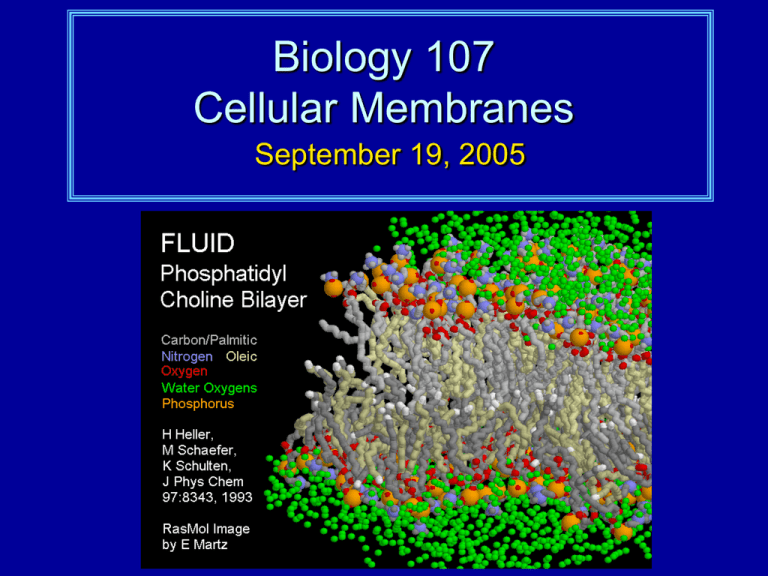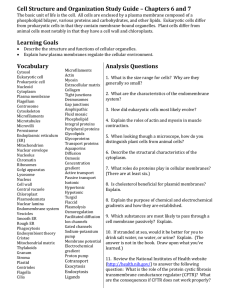Biology 107 Cellular Membranes September 19, 2005
advertisement

Biology 107 Cellular Membranes September 19, 2005 Cells are Microscopic Structures All cells are delimited by a membrane The size of cells is limited by the surface area of plasma membrane available for transport of materials into and out of the cell Phospholipids are Amphipathic Molecules The Nature of Phospholipid Molecules Directs the Spontaneous Assembly of Bilayers in Aqueous Environments Polar (hydrophilic) head region Non-polar (hydrophobic) tail region Lipid Bilayer The Cellular Membrane Bilayer is Associated with Proteins Computer Model of Lipid Bilayer Functions of Membrane Proteins Transport – Active or passive Enzymatic Signal transduction Cell-cell recognition Cell-cell adhesion Cell-matrix adhesion Transmembrane Protein Example of Transmembrane Protein Movement Across Membranes Passive – driving force is diffusion gradient. May use membrane protein(s) to facilitate movement through bilayer, but some molecules (e.g., water) cross membranes unaided by proteins. Active – driving force is cellular energy supply (e.g., ATP). Uses membrane proteins. Transport Across Membranes Osmosis Across Cell Membranes Experiment that Shows the Fluid Nature of Membranes Fluid Nature of Membranes Phospholipids not covalently linked together Lipid composition (e.g., cholesterol amount/location; degree of saturation of fatty acids) affects the degree of fluidity and “flexibility” of membranes Lipid “sea” forms the environment in which membrane proteins may be embedded Fluid Mosaic Model of Membranes Cellular Membranes Student Objectives: As a result of this lecture and the assigned reading, you should understand the following: 1. Membranes confine the contents of cells. 2. Membranes provide the structural basis for metabolic order in organisms. They partition and compartmentalize functions, such as different enzyme systems. Membranes also form the physical matrix on which enzymes may be positioned. 3. Membranes are selectively permeable. Control of exchanges necessary to: 1) protect the cell's integrity; 2) maintain the conditions at which optimal metabolic activities take place; and 3) coordinate the activities of different cells in a multicellular association. Cellular Membranes 4. The main structural components of membranes are lipids, mainly phospholipids containing a hydrophilic polar head region and a hydrophobic non-polar tail region, that spontaneously form stable bilayers. 5. Much of the selective permeability of membranes depends upon the proteins present. 6. The two mechanisms of crossing a membrane are: 1) passive transport (e.g., diffusion) or 2) active transport. Cellular Membranes 7. Membrane proteins may be peripheral proteins or integral proteins depending upon the degree of interaction with the membrane. Integral membrane proteins often span the thickness of the bilayer. 8. The model that best explains the organization of membranes is the fluid mosaic model. Fluid Mosaic Plasma Membrane as an Interface Between Intracellular and Extracellular Environments




